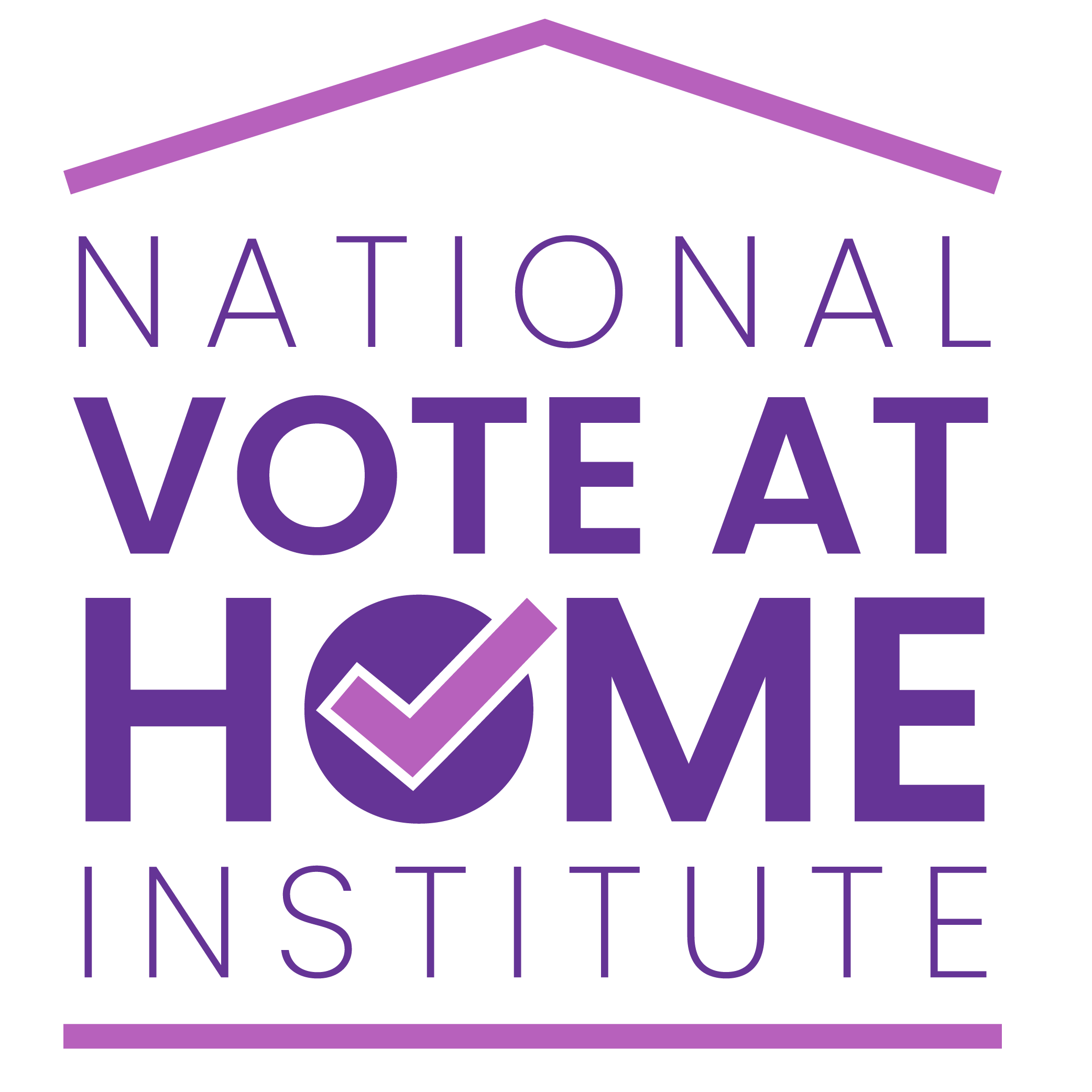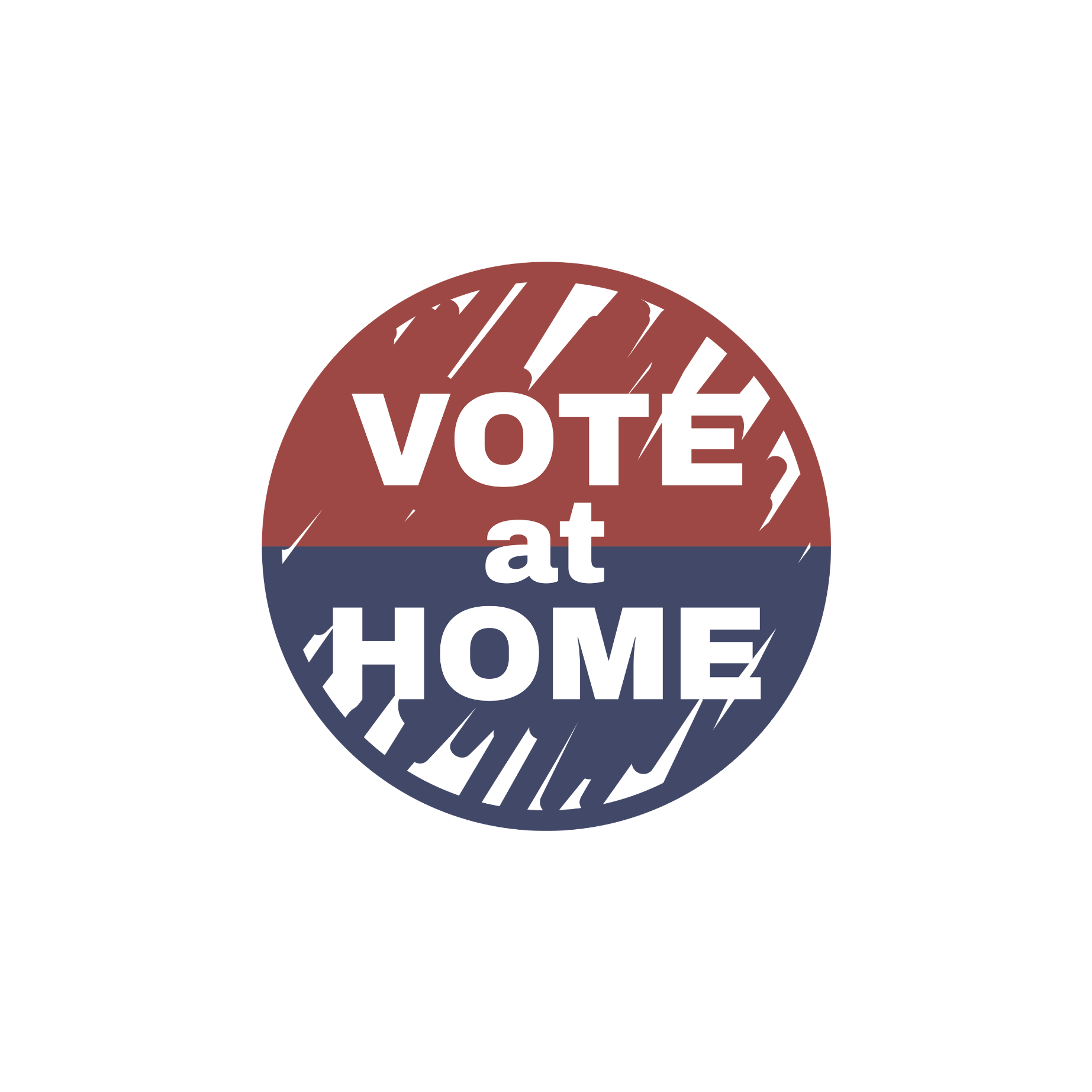Encourages robust turnout in safe and secure elections
Continue readingVOTING AT HOME IS BIG WINNER IN TUESDAY’S ELECTION
Encourages robust turnout in safe and secure elections
Continue readingMaine’s Question 1 Threatens to Silence Tens of Thousands of Voters
Maine’s Question 1 Threatens to Silence Tens of Thousands of Voters
Continue readingNational Vote at Home Institute Files Amicus Brief Urging Court to Block Ballot Receipt Deadline in Executive Order, Calls Out Federal Overreach
The National Vote at Home Institute (NVAHI), a nonpartisan nonprofit dedicated to expanding secure Vote at Home systems, filed an amicus brief in support of the Washington/Oregon suit challenging Section 7(a) of Executive Order No. 14248, which would require mailed-out ballots to be received, rather than postmarked, by Election Day in federal elections.
NVAHI argues that this provision of the executive order is unconstitutional and would disenfranchise tens of thousands of lawful voters, particularly those in rural areas or with limited access to ballot drop boxes.
“The U.S. constitution is clear on this issue. Every state determines how its elections will be run. This executive order is not just about ballot deadlines, it’s about a power grab of unprecedented federal overreach into state elections,” said Barbara Smith Warner, NVAHI executive director.
Over the last 20 years, more than one billion ballots have been delivered safely to voters across the United States. All 50 states and Washington, D.C., now allow Vote at Home in some form, and 18 states accept ballots postmarked by Election Day, a standard that is both secure and essential for protecting voting rights.
Our amicus brief includes findings that show:
- Vote at Home systems increase voter turnout by an average of 3-4 percentage points
- Fraud is exceedingly rare, with fewer than 0.00006% of roughly 250 million mailed-out ballots over 20 years showing any credible evidence of fraud.
- States that expanded Vote at Home access saw increased participation among voters with disabilities and young voters, particularly voters of color.
- Rural voters would be disproportionately harmed by an Election Day receipt deadline, due to slower mail delivery and fewer ballot drop boxes.
The brief cites recent warnings from the National Association of State Election Directors and the U.S. Postal Service acknowledging growing delays in ballot delivery, especially in rural communities.
“This Executive Order is a direct threat to voters. Thousands of Americans who follow the rules and mail their ballots on time could be silenced because of mail delays beyond their control. That’s not democracy, it’s disenfranchisement,” said Smith Warner.
About National Vote At Home Institute
The National Vote at Home Institute is a nonpartisan, nonprofit organization that works to increase voters’ access to, use of and confidence in mailed-out ballots. Since 2018, NVAHI has helped policymakers and election administrators facilitate innovation of Vote at Home systems by providing resources and best practices on research, policy and communications. Our long-range vision is a nationwide Universal Vote at Home election system in which all active registered voters are automatically delivered their mailed-out ballot, to be returned by postage-free mail or in person to a wide range of secure locations, can track them online in real-time, and easily and promptly correct any administrative errors.
Census Bureau Voting Data Highlights Turnout-Boosting Power of Vote at Home Systems
Every two years, the U.S. Census Bureau releases a comprehensive report on voting turnout patterns among states and key demographic groups for the most recent general election. The latest report on the November 2024 election showed once again the turnout-boosting power of Vote at Home election systems: when more voters have their ballots delivered to them, more of them vote.
A unique element of the Census data is information on non-voters and what kept them from casting a ballot. Many of those reasons are eliminated by automatically mailing a ballot to every voter: “out of town,” “transportation problems” “bad weather” or “inconvenient polling place” are irrelevant when your ballot is automatically delivered to you, and you can mail it or return it in person at your convenience.
According to the 2024 Census report, 44% of non-voters in non-Western states cited such logistical barriers. These regions had low use of mail ballots: 21% in the Northeast, 18% in the Midwest, and 11% in the South (Table 14).
But in the 13 Western states, where 74% of those voting said they voted with mail ballots, just 34% of non-voters cited the same reasons (Table 10).
Overall, about 50 million registered voters did not vote in 2024, according to official state voter registration records. Having 10% fewer voters thwarted by logistical hurdles could have resulted in 5 million additional ballots cast nationwide.
“There’s no simpler or more powerful approach to both protect voting rights and dramatically boost voter participation than adopting the ‘Vote at Home’ election system approach now used in eight states and the District of Columbia,” said NVAHI Executive Director Barbara Smith Warner.
Oregon, which pioneered Universal Vote at Home elections in 2000, continues to lead the nation in turnout despite not being a battleground state or having a US Senate or gubernatorial race on the ballot in 2024.
“Voting is a fundamental American right, and it’s our duty to make sure every citizen can exercise that right. Voting from home is the safe, secure, and efficient way for Americans to hold their politicians accountable, and the numbers here in Oregon prove it,” said Oregon Secretary of State, Tobias Read. “I’m proud that our state is leading the way, and everyone who agrees that elections must reflect the will of the people should follow our lead.”
Other highlights from Oregon’s turnout include:
75.27% turnout among eligible citizens — second only to Minnesota and 10 points above the national average (Table 4b).
Among Hispanic voters, Oregon’s turnout ranked 6th nationally at 62%, 12 points above the national average.
Among voters aged 18–44, Oregon ranked 5th; among those 65 and older, it ranked 2nd; both 10 points above national rates.
Oregon outperformed all seven 2024 presidential battleground states, despite their record-breaking campaign spending and voter outreach (Table 4c).
Notably, Black voter turnout in Oregon — a state with a relatively small Black population — ranked #1 in the nation at nearly 80% (Table 4b).
About National Vote At Home Institute
The National Vote at Home Institute is a nonpartisan, nonprofit organization that works to increase voters’ access to, use of and confidence in mailed-out ballots. Since 2018, NVAHI has helped policymakers and election administrators facilitate innovation of Vote at Home systems by providing resources and best practices on research, policy and communications. Our long-range vision is a nationwide Universal Vote at Home election system in which all active registered voters are automatically delivered their mailed-out ballot, to be returned by postage-free mail or in person to a wide range of secure locations, can track them online in real-time, and easily and promptly correct any administrative errors.
New Report on Primary Voting Highlights Path to Increase Voter Participation
Universal Vote at Home states that automatically sent ballots to all active registered voters saw nearly double the national turnout rate
Today, the National Vote at Home Institute (NVAHI) issued a research paper examining turnout in the 2024 primary election cycle. In addition to documenting the abysmal overall turnout – with more than four in five voters not participating – the report found that Universal Vote at Home (VAH) states produced nearly double the turnout rate of non-Vote at Home states in primary elections. This super minority of voters determine the results of primary races that are now so important that they effectively choose an estimated 90% of winners for top federal and state offices.
In regular State Primary Elections, where voters chose Republican and Democratic party nominees for the November general election, only 44 million of an estimated 235 million eligible citizens cast ballots, or less than 1 in 5. In contrast, Universal Vote at Home states, where every active registered voter is automatically delivered a ballot, aggregate primary election turnout levels were approximately double those in polling-place-centric states. In these jurisdictions, the combined turnout was 30% of eligible citizens and 34% of registered voters, compared to 16% and 19% in non-VAH states.
“There’s arguably no simpler or more powerful approach to dramatically boost participation in these critical elections than adopting the “Vote at Home” election system approach now used in eight states and the District of Columbia,” noted Phil Keisling, former Oregon Secretary of State and chief author of the report.
The NVAHI analysis also revealed that the median age – half older, half younger – of 2024 primary voters nationwide was 65. Voters 65 and older had a six-times higher turnout rate (36%) than those aged 18-34, who had just a 6% turnout. VAH states also consistently showed higher voter turnout across all age groups.
“This report is the latest in a long line of evidence of how Vote at Home transforms elections by centering the voter in the process,” said NVAHI Executive Director Barbara Smith Warner. “For disabled voters, younger voters, primary voters and all voters, Vote at Home means elections that are safe, secure and accessible to all.”
Read the Executive Summary and Full Report here.
About the National Vote at Home Institute
Founded in 2018, the National Vote at Home Institute is a nonpartisan 501(c)(3) organization that works to increase voters’ access to, use, and confidence in voting at home, where voters are delivered their ballot, return them by postage-free mail or in-person to a range of accessible, convenient and secure locations, and can track them online to ensure their vote is
Voting at Home Remains Secure as Local Election Officials Respond to Election Interference Attempts in Oregon and Washington State
(October 29, 2024) — Ballot boxes were set on fire in Oregon and Washington state this week in an attempt to discourage Americans from participating in the most vital element of our democracy—voting. Yet Voting at Home maintains its strength and resilience as a secure voting method. The incidents have been met with swift action from local election officials committed to preserving the integrity of the electoral process and who have previously implemented robust security measures to protect mailed-out ballots against any attempts at voter fraud.
“Voting at home continues to be a safe and convenient method of voting that maximizes voter engagement and participation. Its security features, from unique ballots tied to each voter to signature verification, ballot tracking, and ballot curing, have been on display through the response to these attacks,” said Barbara Smith Warner, executive director of the National Vote at Home Institute.
In response to the acts of vandalism, local officials from Multnomah County, Oregon, and Clark County, Washington, have reaffirmed their dedication to safeguarding the electoral process. Both counties executed security plans to address the threat, demonstrating their readiness to counteract election interference. Since 2018, jurisdictions have received $952 million in election security funding to enhance security and maintain their constituents’ trust.
“Your vote is your voice, and we applaud the work of local election officials who remain resolute against attempts to undermine the electoral process,” added Smith Warner. “The integrity of our democratic process is paramount, and any interference with our elections will face harsh legal consequences.”
About the National Vote at Home Institute
Founded in 2018, the National Vote at Home Institute is a nonpartisan 501(c)(3) organization that works to increase voters’ access to, use, and confidence in voting at home, where voters are delivered their ballot, return them by postage-free mail or in-person to a range of accessible, convenient and secure locations, and can track them online to ensure their vote is
Nearly 4-In-5 Registered Voters Failed To Cast a Ballot in 2024 Primaries, While Highest Turnout Seen in Vote at Home States
Primary elections, a crucial part of the democratic process where many races are functionally decided, continue a distressing trend in 32 contests through April 24
(April 25, 2024) — According to an analysis released by the National Vote at Home Institute this week, of an estimated 149 million registered voters eligible to vote in 32 state primary contests held through April 24, 2024, only ~34 million cast a ballot; an aggregate turnout of approximately 23% if using active registered voters and a no-show rate of nearly 5-in-6 potential voters using all eligible citizens.
“What these states are missing is a powerful election reform that has the potential to double or even triple voter turnout,” says Barbara Smith Warner, executive director of the National Vote at Home Institute. “In the Vote at Home election states, where ballots are automatically delivered to all active registered voters, there’s no need to request a mailed-out ballot or travel to a polling place, and the resulting turnout shows the difference it makes.”
Through April 24, states have held three types of primary elections: 24 states held presidential preference-only contests; seven states held full state primaries, where voters chose Democratic and Republican party finalists for candidates for all federal and state positions; and one state, Wisconsin, paired its presidential contest with legislatively referred statewide ballot measures.
Among the 24 presidential preference-only states, registered voter turnout has averaged just 21%, ranging from lows of 5% to 10% in New York, Connecticut, and Rhode Island to 50% in New Hampshire, which regularly has a high turnout for presidential primaries. In contrast, Vote at Home states saw a rate of 35% in Washington and 39% in Colorado, roughly double the turnout of other Super Tuesday states with comparable demographics (e.g., Tennessee (17%), Minnesota (17%), and Virginia (19%).
The turnout rates in six states that held full state primaries—Illinois (17%), Texas (18%), Alabama (21%), Ohio (22%), North Carolina (24%), and Pennsylvania (24%)—fell short of that in California (35%), which automatically delivered ballots to all registered voters. This pattern mimics National Vote at Home data from the 2022 primary election and demonstrates a significantly higher turnout in Vote at Home states.
“Delivering ballots in California reminded voters that an election was imminent and provided them time to study their options and cast an informed ballot,” said Smith Warner.
National Vote at Home Institute research examining 18-34-year-old voter turnout found that young voters had significantly higher turnout rates in the 10 Vote at Home states and Washington, D.C., that automatically delivered ballots to all active registered voters in 2020. Yet, the median age of voters in 2022 was 62* nationwide with turnout among 65+ voters was nearly 43%, compared to 10% for 18-34-year-olds.
“It’s great that 65+ Americans are well-connected to our elections, but young voters, who will constitute 44% of voters in 2028, feel estranged from our current political climate,” said Smith Warner. “We should be committed to solving a problem that threatens the key to our democracy’s future.”
Voter engagement is crucial, and using mail ballots to Vote at Home is a potential game-changer in pursuing decisive election reform.
*In states with age-available data.
About the National Vote at Home Institute
Founded in 2018, the National Vote at Home Institute is a nonpartisan 501(c)(3) organization that works to increase voters’ access to, use, and confidence in voting at home, where voters are delivered their ballot, return them by postage-free mail or in-person to a range of accessible, convenient and secure locations, and can track them online to ensure their vote is
National Vote at Home Institute Releases Comprehensive Guide on How to Vote at Home in Every State
The resource lays out the Vote at Home process, from ballot requested to ballot counted, as a tool for civic engagement groups seeking to boost voter access and turnout through the increased use of mailed-out ballots.
(April 16, 2024) — The National Vote at Home Institute (NVAHI) is excited to announce the launch of its comprehensive state-by-state How Americans Vote at Home tool. Mail ballot policies vary widely; this resource provides state-specific particulars on Vote at Home policies and processes to support nationwide efforts to promote mail ballot use. How do voters request and return their mail ballot? Is there a witness requirement? Can they track their ballot from being mailed to being counted? What happens if there’s an issue with their ballot? Are there limits on third-party involvement?
“More Americans voted at home in 2020 than by any other method, and that helped drive voter turnout to its highest level in more than a century,” said Barbara Smith Warner, executive director of the National Vote at Home Institute. “While the popularity of Vote at Home has continued to grow, many states have changed their rules on how to access it. As we approach the next presidential election, we want to make sure that voters can continue to utilize the safety and convenience of voting at home.”
Vote at Home (vote-by-mail or absentee voting) has become increasingly popular with American voters as access to it has expanded. Today, 3 in 4 voters can Vote at Home for any reason, and nearly 40% are automatically delivered or can opt-in to be delivered a mail ballot for all elections. Voting at home centers the voter’s convenience by delivering their ballot to their doorstep, offers more time and opportunities to return it, and eliminates the concerns of long poll lines, work or child care conflicts, or weather emergencies.
Over the last twenty years, NVAHI estimates that over 1 billion ballots have been delivered nationwide for presidential and midterm elections, party primary races, special vacancies, and local elections. The convenience of Vote at Home has led to higher voter turnout in states that automatically deliver ballots to every active registered voter. In 2022, Oregon, which pioneered full Vote at Home, had the highest turnout of eligible voters at over 60%.
“As an Oregonian, I’ve been Voting at Home since 2000. Now, in a year that faces poll worker shortages, long wait times and safety concerns, we want to help as many voters as possible to Vote at Home.”
The tool is primarily intended for civic engagement groups of all shapes and sizes nationwide, to help them successfully integrate Vote at Home into their voter registration and voter engagement programs. Using state specific information about How Americans Vote at Home, available on the NVAHI website, can help boost voter access and turnout through the increased use of mailed-out ballots.
About the National Vote at Home Institute
Founded in 2018, the National Vote at Home Institute is a nonpartisan 501(c)(3) organization that works to increase voters’ access to, use, and confidence in voting at home, where voters are delivered their ballot, return them by postage-free mail or in-person to a range of accessible, convenient and secure locations, and can track them online to ensure their vote is counted.
National Vote at Home Institute Welcomes New Board Members
Non-profit organization working to deliver more ballots to voters in every state welcomes a trio of activists and advocates.
(February 1, 2024) — National Vote at Home at Home Institute is kicking off this year with the appointment of three new board members: Judy Beard of the American Postal Workers Union; Kori Blalock Keller of the National Association of Letter Carriers; and Winn Khuong of Action Together™ New Jersey.
“With the Voting Rights Act under increased attack, there’s never been a more important time to expand access to voting at home,” said Executive Director Barbara Smith Warner. “Delivering ballots to voters increases voter participation, saves money, and has multiple security features. Our new board members all have deep knowledge about voting at home, and will bring that to bear on NVAHI’s work in 2024 and beyond to encourage its use as a turnout tool and make it more accessible in every state.”
Judy Beard is the Legislative and Political Director at the American Postal Workers Union. Beard was elected Retirees Department director in November 2007 and is the first woman legislative director in the union’s history. Beard got her postal start in 1970 in Detroit and held many union offices in the Detroit District Area Local, including teaching at the University of Michigan’s School of Industrial Relations, before coming to Washington, D.C.
Kori Blalock Keller is the Chief of Staff at the National Association of Letter Carriers, serving as the principal advisor to the President for all union matters. At NALC, Keller successfully led a coalition of postal stakeholders and bipartisan, bicameral efforts to enact meaningful postal reform following years of inaction. Before joining NALC, Keller spent ten years with the Professional Aviation Safety Specialists, AFL-CIO (PASS), a Federal Aviation Administration (FAA) union, serving as its chief spokesperson and Legislative and Political Representative.
Winn Khuong is the Founder and the Executive Director of Action Together™ New Jersey Education Fund, a nonpartisan 501(c)3 voter education organization. Khuong has been honored with the Alice Paul Award, the Russ Berrie Award, and the New Jersey State Governor’s Jefferson Awards in the Founder/Innovator category. She serves on the Steering Committee of Rising Stars at the Eagleton Institute and previously on Governor Murphy’s Diversity and Inclusivity Council. Khuong was a speaker at the 2018 and 2019 Women’s March, 2018 March for Our Lives, and has appeared in the New York Times, PBS Newshour, and numerous media outlets.
Opportunities to vote at home in 2024 are significant, and the appointment of these remarkable members will propel the critical work of the National Vote at Home Institute, democracy partners, and, most importantly, American voters.
About National Vote At Home Institute
The National Vote at Home Institute is a nonpartisan nonprofit organization that works to increase voters’ access to, use of, and confidence in voting at home, in which voters are delivered mailed-out paper ballots; return them either by postage-free mail or in-person to a wide range of accessible, convenient, and secure locations; and can track them online, in real-time, to ensure their vote is counted.



